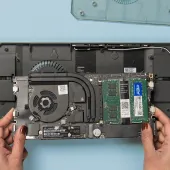The Evolution of the iMac: From Bondi Blue to M1 Chip
The Early Years
When the iMac was introduced in 1998, it was a departure from the beige boxes that dominated the personal computing landscape. The first iMac had a colorful, translucent shell, and it came in a variety of colors, including Bondi Blue, Tangerine, and Grape. The iMac was an all-in-one computer, meaning that the computer and the monitor were integrated into one unit.
The iMac was a hit from the start. It was easy to set up and use, and it had a built-in modem and ethernet port, making it easy to connect to the internet. The iMac also had a USB port, which was a new technology at the time, and it was the first computer to ship without a floppy disk drive.
The iMac G3
The iMac G3 was the first model of the iMac and it was produced from 1998 until 2003. It was designed by Jonathan Ive and was available in many colors, including the iconic Bondi Blue. The iMac G3 was powered by a PowerPC G3 processor, and it had a 15-inch CRT display.
The iMac G4
The iMac G4 was introduced in 2002, and it was a departure from the iMac G3. The iMac G4 had a lamp-like design, with a flat panel display on top of a swiveling arm. The iMac G4 was available in two sizes, 15-inch and 17-inch, and it was powered by a PowerPC G4 processor.
The iMac G5
In 2004, the iMac G5 was introduced, and it was the first iMac to use an aluminum enclosure. The iMac G5 had a slim design, and it was available in two sizes, 17-inch and 20-inch. The iMac G5 was powered by a PowerPC G5 processor, and it had a built-in iSight camera.
The Intel Years
In 2006, Apple announced that it would be transitioning its Mac computers from PowerPC processors to Intel processors. The iMac was one of the first Mac computers to make the switch, and the first Intel-based iMac was introduced in 2006.
The iMac (Mid 2007)
The iMac (Mid 2007) was the first iMac to use an aluminum and glass enclosure. The iMac (Mid 2007) was available in two sizes, 20-inch and 24-inch, and it was powered by an Intel Core 2 Duo processor.
The iMac (Early 2008)
The iMac (Early 2008) was a minor update to the iMac (Mid 2007). It was available in the same sizes and had the same processor, but it had a few new features, including a built-in iSight camera and a new keyboard design.
The iMac (Late 2009)
The iMac (Late 2009) was a major update to the iMac line. It featured a new design with a larger, 27-inch display and a slim, aluminum body. The iMac (Late 2009) was powered by an Intel Core i5 or i7 processor, and it had a built-in SD card slot and a Mini DisplayPort for connecting an external display.
The iMac (Mid 2010)
The iMac (Mid 2010) was another minor update to the iMac line. It was available in the same sizes as the previous model and had the same processor options, but it had a few new features, including a higher resolution display and support for Apple's Magic Trackpad.
The iMac (Mid 2011)
The iMac (Mid 2011) was a significant update to the iMac line. It featured a new design with a slim, aluminum body and a thin bezel around the display. The iMac (Mid 2011) was powered by an Intel Core i5 or i7 processor, and it had a high-resolution display with a 16:9 aspect ratio. It also had a Thunderbolt port, which allowed for faster data transfer speeds and the ability to connect to external displays.
The iMac (Late 2012)
The iMac (Late 2012) was another major update to the iMac line. It featured a new, ultra-thin design with a 21.5-inch or 27-inch display. The iMac (Late 2012) was powered by an Intel Core i5 or i7 processor, and it had a new Fusion Drive option, which combined a solid-state drive and a traditional hard drive for faster performance and increased storage.
The iMac (Late 2013)
The iMac (Late 2013) was a minor update to the iMac line. It had the same design as the previous model, but it was powered by a faster Intel Core i5 or i7 processor and had improved graphics performance.
The iMac with Retina 5K Display
In 2014, Apple introduced the iMac with Retina 5K Display. This model had a 27-inch display with a resolution of 5120 x 2880 pixels, making it one of the highest-resolution displays available at the time. The iMac with Retina 5K Display was powered by an Intel Core i5 or i7 processor and had a faster graphics card to support the high-resolution display.
The iMac Pro
In 2017, Apple introduced the iMac Pro, a high-end version of the iMac designed for professional users. The iMac Pro had a sleek, space-gray design and was powered by an Intel Xeon processor with up to 18 cores. It also had a Radeon Pro Vega graphics card, up to 128GB of RAM, and up to 4TB of solid-state storage.
The M1 iMac
In 2021, Apple announced the M1 iMac, the first iMac to use Apple's own M1 chip. The M1 iMac had a new, slim design with a 24-inch display and was available in seven colors. It was powered by an M1 chip with up to 8 cores, and it had a high-resolution display with True Tone technology. The M1 iMac also had a new, improved camera and microphone system, making it ideal for video conferencing.
Conclusion
The iMac has come a long way since its introduction in 1998. From the colorful iMac G3 to the sleek M1 iMac, the iMac has always been at the forefront of desktop computing technology. With each new iteration, the iMac has become more powerful, more versatile, and more user-friendly. Today's iMacs are not only powerful desktop computers, but they also serve as entertainment centers, communication hubs, and creative workstations.
Throughout its history, the iMac has been a symbol of innovation and design excellence, reflecting Apple's commitment to creating products that are both beautiful and functional. It has been a hallmark of the Apple brand, and it has inspired countless imitators in the world of personal computing. As we look to the future, it will be exciting to see where the iMac goes next and how it will continue to shape the world of personal computing.



